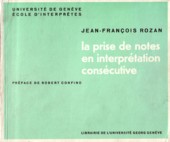This extract is taken from a new translation of Jean-Francois Rozan’s La Prise de notes dans l’interprétation consécutive. It is a short passage that has defined the teaching and practice of consecutive interpreting since it was written 50 years ago.
La prise de notes en interprétation consécutive, Rozan, Jean Francois, 1956 Geneve . Georg. To see a longer extract click here.

1. Noting the idea rather than the word
Take any French text and give it to 10 excellent english translators. The result will be ten very well translated texts, but ten very different texts in as far as the actual words used are concerned. The fact that we have ten good translations, but ten different texts, shows that what is important is the translation of the idea and not the word. This is even truer of interpretation since the interpreter must produce a version of the text in another language immediately. He must be free of the often misleading constraints that words represent. It is through the analysis and notation of the ideas that the interpreter will avoid mistakes and a laboured delivery. Example: Let us take the following, from French into English:
„Il y a des fortes chances pour que…../ There is a very good chance that…”
If we base our notation of this expression on the words, the key word is chance. If we base it on the idea, it is probable.
The notes will have to be read 20 minutes – even an hour – after the idea was originally expressed. In the first example it would be very easy to make a mistake. Having noted chance the interpreter might, if the context allowed, render it „there is a chance that” or „by chance”. If on the other hand he noted probable the mistake cannot be made. The issue of style is also dealt with in the second example where one would automatically say (interpreting into English), „It is probable that”, or „it is likely that”, or „in all likelihood” whereas in the first example even if the interpreter had correctly recalled the idea that the word chance represented he/she will be a prisoner to that word and might easily produce a gallicism . Example:
„We should try to live up to….”
It would be absurd to note the word „live” and it would greatly increase the risk of making a mistake. Although it would seem to be very different from the original it would be more appropriate to note in French, for example, „ a la hauteur” (in english ‘to be up to’). This is the result of analysing the idea behind what is said and noting it idiomatically in the target language. It would be just as useful to note
be =
…representing being equal to , which could very easily be read back idiomatically in intepretation (ie. „a la hauteur in French”, „to be up to in English”).
Whenever taking notes the interpreter must concentrate on the major idea and how this can be noted clearly and simply (preferably in the target language, although this is not essential).